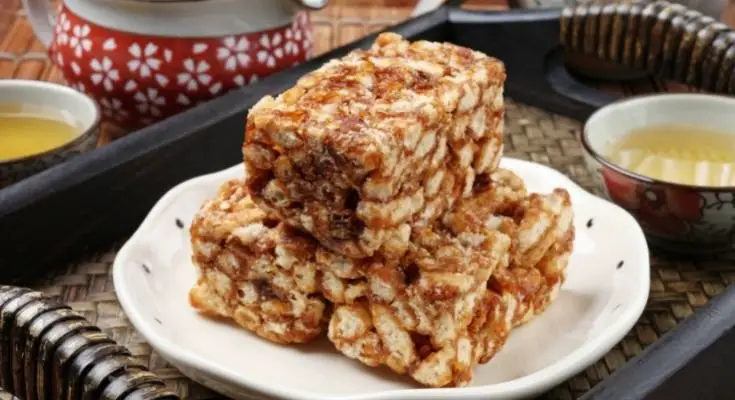Sachima cake is a traditional Chinese dessert that has been around for centuries. This sweet and crunchy pastry is made from flour, sugar, and eggs and has a crispy texture with a chewy center. It is a popular snack in China and other Asian countries and has a fascinating history that goes back several generations.
What is Sachima Cake?
Sachima cake is a type of Chinese pastry that is made by frying or baking a mixture of flour, sugar, and eggs until it becomes crispy and golden brown. The cake is then cut into small pieces and served as a snack or dessert. Sachima cake has a unique texture that is both crispy and chewy, making it a delicious treat for anyone with a sweet tooth.
The Origin of Sachima Cake
The origin of sachima cake can be traced back to the Han Dynasty in China, which dates back to 206 BC. During this time, the cake was known as “han mei” and was made using rice flour, honey, and sesame seeds. It was a popular snack among the people of China and was often served during festivals and special occasions.
Over time, the recipe for han mei evolved, and it became known as sachima cake. During the Qing Dynasty, which lasted from 1644 to 1912, the cake became even more popular and was considered a luxury food item that was often served to royalty and wealthy families.
How Sachima Cake is Made
To make sachima cake, you will need the following ingredients:
- Flour
- Sugar
- Eggs
- Baking powder
- Oil
- Water
First, mix the flour, sugar, baking powder, and eggs together in a bowl. Add water gradually while mixing until the dough becomes smooth and soft. Roll the dough into thin sheets and cut them into small pieces. Fry the pieces in hot oil until they become crispy and golden brown. Finally, drain the excess oil, let them cool, and serve them as a snack or dessert.
Variations of Sachima Cake
There are many different variations of sachima cake, each with its unique flavor and texture. Some popular variations include:
- Chocolate Sachima Cake: This variation adds cocoa powder to the dough, giving it a rich, chocolatey flavor.
- Peanut Sachima Cake: This variation adds peanut butter to the dough, giving it a nutty flavor.
- Sesame Sachima Cake: This variation adds sesame seeds to the dough, giving it a nutty flavor and a crunchy texture.
The Popularity of Sachima Cake
Sachima cake has been a popular snack in China and other Asian countries for many generations. Its unique texture and sweet taste make it a favorite among both young and old. Today, sachima cake is not only sold in traditional bakeries and markets but can also be found in modern supermarkets and online stores.
FAQs
No, sachima cake is not vegan-friendly, as it contains eggs.
Sachima cake can last for up to two weeks when stored in an airtight container at room temperature.
Yes, sachima cake can be frozen, but it is best eaten fresh.
Sachima has a unique texture that is both crispy and chewy. The outside of the cake is crispy, while the inside is soft and chewy, making it a delightful treat for anyone who loves desserts with contrasting textures.
While sachima cake is undoubtedly delicious, it is not considered a healthy snack due to its high sugar and calorie content. It is best enjoyed in moderation as an occasional treat.
Conclusion
Sachima cake is a traditional Chinese dessert with a fascinating history that goes back several centuries. Its unique texture and sweet taste have made it a favorite snack among people of all ages, not only in China but in other parts of the world as well. Whether you’re a fan of the original recipe or one of its many variations, sachima cake is a delicious treat that is sure to satisfy your sweet tooth.

